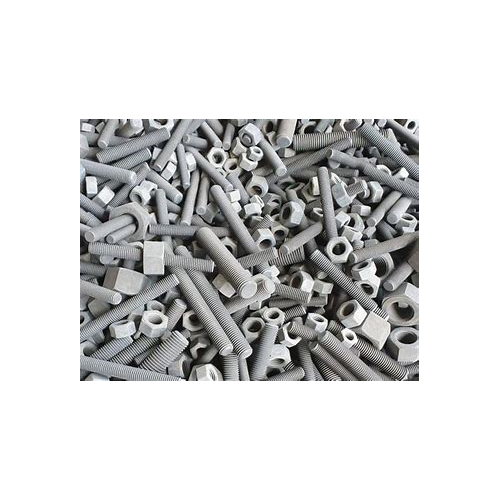Specification
- घनत्व
- ग्राम प्रति घन सेंटीमीटर (g/cm3)
- स्वाद
- गंध
- पवित्रता
- 99%
- प्रपत्र
- घुलनशीलता
- Insoluble in water
- आणविक भार
- 386.11 g/mol
- स्ट्रक्चरल फॉर्मूला
- Zn3(PO4)2
- मेल्टिंग पॉइंट
- Above 1000°C
- दुसरे नाम
- Phosphoric Acid Zinc Salt
- शेप
- पीएच लेवल
- 6.0 – 7.5 (in bath solution)
- आण्विक सूत्र
- Zn3(PO4)2
- विषैला
- Yes
- एच एस कोड
- 32099090
- स्टोरेज
- वर्गीकरण
- रासायनिक नाम
- Zinc Phosphate
- कैस नं
- 7779-90-0
- ईआईएनईसीएस नं
- 215-236-1
- ग्रेड
- स्टैण्डर्ड
- IS 3618, ASTM D 769
- टाइप करें
- Phosphate Coating Service
- उपयोग
- Surface Coating, Metal Pretreatment
- मुख्य सामग्री
- Zinc Phosphate
- एप्लीकेशन
Trade Information
- Minimum Order Quantity
- 1 Unit
- भुगतान की शर्तें
- , ,
About
Zinc phosphating, also known as zinc phosphate coating, is a type of conversion coating used to protect steel surfaces. Heres a detailed profile:
Process
- Cleaning: The steel surface is thoroughly cleaned to remove any contaminants.
- Rinsing: The cleaned surface is rinsed to remove any cleaning agents.
- Phosphating Bath: The steel is immersed in a zinc phosphate solution, typically at a temperature of around 50-75C. This causes a chemical reaction that forms a layer of zinc phosphate on the surface.
- Rinsing: The phosphated surface is rinsed again to remove any residual chemicals.
- Sealing: The surface is often sealed with oil or another protective coating to enhance corrosion resistance.
Benefits
- Corrosion Resistance: Provides excellent protection against rust and corrosion.
- Adhesion: Enhances the adhesion of subsequent coatings or paints.
- Wear Resistance: Improves the wear resistance of the treated surface.
Applications
- Automotive Industry: Used for engine components, gears, and other parts that require high wear resistance.
- Military and Defense: Applied to weapons and ammunition for corrosion protection.
- Machinery: Used in various machinery parts to improve durability and performance
Robust Corrosion Protection
Zinc Phosphate coatings provide premium protection against corrosion for metal surfaces. The dense, insoluble layer offers long-term durability, making it a preferred choice in automotive and industrial applications. Its effectiveness extends the lifespan of components, even in harsh environments, and the coating remains stable at high temperatures.
Versatile Application Methods
The service utilizes both immersion and spray techniques for optimal coverage, depending on the component type and project requirements. With treatment temperatures ranging from room temperature up to 65C, the process is adaptable to a variety of operational setups, ensuring excellent adhesion on all surfaces treated.
Compatibility and Shelf Life
Zinc Phosphate coatings are compatible with both water-based and solvent-based paint systems. This flexibility simplifies integration into existing finishing processes. Treated surfaces retain their protective qualities for up to 12 months without a topcoat, providing lasting value before further painting or processing.
FAQs of Zinc Phosphate Coating सेवाएं:
Q: How is Zinc Phosphate Coating applied to metal surfaces?
A: The Zinc Phosphate Coating is applied using either immersion or spray techniques, depending on the component geometry and project requirements. Both methods ensure uniform coverage and form a protective layer ranging between 515 microns in thickness.Q: What is the main advantage of using Zinc Phosphate Coating for industrial components?
A: Zinc Phosphate Coatings offer excellent adhesion and corrosion resistance, effectively extending the lifespan of metal components used in automotive, engineering, and industrial applications. The coating is also compatible with various paint bases for enhanced protection.Q: When is a Zinc Phosphate Coating service recommended for metal pretreatment?
A: Zinc Phosphate Coating is ideal for pretreatment before painting or finishing metal surfaces, especially when robust corrosion resistance and high adhesion are required. It is recommended for ensuring optimal performance in challenging environments.Q: Where can Zinc Phosphate Coating services be used?
A: These services are suitable for a wide range of industries, including automotive, engineering, and general industrial manufacturing. Typical applications involve metal parts, surfaces, and components that require protection and preparation before further finishing.Q: What is the shelf life of a Zinc Phosphate coated surface without additional topcoat?
A: A surface treated with Zinc Phosphate Coating retains its corrosion-resistant properties for up to 12 months without a topcoat, given proper storage in a cool, dry area as per guidelines.Q: What benefits does Zinc Phosphate Coating offer in terms of safety and environmental impact?
A: Zinc Phosphate coating is non-toxic, odorless, and insoluble in water, contributing to safe handling during application and minimizing environmental impact compared to other industrial pretreatment processes.Q: How does Zinc Phosphate Coating ensure compatibility with different types of paints?
A: The coatings surface chemistry supports excellent adhesion with both water-based and solvent-based paints, making it versatile and easy to integrate into diverse finishing systems for enhanced protection.
- Minimum Order Quantity
Tell us about your requirement

Price: Â
Quantity
Select Unit
- 50
- 100
- 200
- 250
- 500
- 1000+
Additional detail
मोबाइल number
Email



